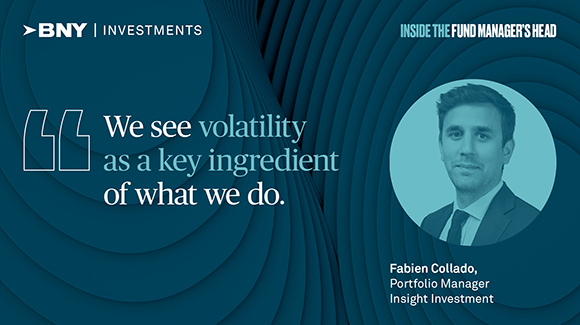While passive equity funds have become a staple in many portfolios, passive fixed income strategies have yet to gain the same traction among UK financial advisers and wealth managers. Our latest BNY Insight Fixed Income report reveals why active management remains the preferred choice for 64% of fixed income allocations.
From navigating complex market risks to adapting swiftly in volatile environments, active managers offer the expertise and flexibility that advisers value most. Discover why active fixed income continues to outperform and how emerging innovations like active ETFs could shape the future of bond investing.
Active versus passive
While passive equity options have become ubiquitous, passive fixed income has proved a harder sell. Although there is no shortage of products, they have not resonated with advisers and are still only lightly used in client portfolios. However, advisers still see some holes in fixed income provision and emerging passive solutions could be part of the solution.
The BNY Insight Fixed Income report shows that advisers allocate 64%1 of their fixed income investments to active strategies. The structure of fixed income indices has been a notable deterrent. As one fund researcher said: "I am not a fan of using passive in fixed income as I think you are buying the most indebted companies and countries." For many advisers, this seems a poor way to manage risk.
In global indices, it also means having very large weightings in US treasuries and high exposure to the dollar. While this has been a reasonable trade in recent history, there are doubts as to whether it will be in future.
Advisers recognise that bond markets contain inherent inefficiencies that skilled managers can exploit. In the research, 63% of advisers cited "potential for outperformance in less efficient markets" as their primary rationale for choosing active management.
Active managers can also adapt to changing interest rate environments - 49% of advisers said this adaptability was a key factor in their choice. The ability to adjust duration, sector exposure, and credit quality in response to evolving conditions is seen as critical. For 43% of advisers, reducing portfolio volatility is the primary objective of their fixed income holdings. With this in mind, active management's ability to mitigate drawdowns (cited by 39% of advisers) becomes particularly valuable.2
This is not just a theoretical advantage. Advisers recognise that active managers have generally navigated the recent unpredictable interest rate environment better than passive fixed income options. The fixed income portion of many portfolios tends to perform "notably better than its benchmark," one discretionary fund manager said. This consistent outperformance has kept passive growth in check. This was evident in 2022 when interest rates rose sharply: active managers had more tools to manage a difficult environment.
There is every reason to think this will continue. At the moment, credit spreads are at decade lows, with fears that investors are not paying sufficient attention to the various risks in the global economy – from tariffs, geopolitics and high levels of government debt. While “all in” yields remain relatively attractive, risks are building for investors. It is easy to see the appeal of harnessing alpha rather than beta. In a market characterised by real uncertainty, the tactical agility of active management is seen as not just valuable but increasingly necessary.
Problems of analysis
The BNY survey showed a real lack of confidence among advisers on fixed income analysis. Many advisers don’t have the in-house tools to make sophisticated judgments on the risk and reward characteristics of fixed income. While it is relatively easy to understand the risks in a passive equity portfolio, it is more difficult to assess the risks in a passive fixed income portfolio. What is the interest rate exposure, for example? Does this change over time? What is the currency exposure? It is far easier to leave decision-making to a strategic bond manager.
Finally, there is the cost consideration. For equities, the cost difference between active and passive options can be significant and the impact on investor portfolios readily quantified. As one adviser put it, "the cost of passive in the fixed income space is not necessarily as cheap as you might think.” Active and passive fixed income are closer in cost, so the immediate advantage of adopting passive is diminished.
The continued dominance doesn't mean passive has no role. Advisers will often use them for “plain vanilla” sovereign exposure, where active managers can add less value. Equally, it doesn’t mean that active funds are perfect. Our research showed that advisers had been surprised at the way some of their fixed income strategies had performed during periods of market weakness.
Equally, advisers see the need for innovation in fixed income. One highlights the need for solutions that solve the retirement income puzzle. “How do we deliver reliable income streams without exposing clients to unacceptable volatility?" This adviser perspective captures a central challenge facing the industry today: the need to translate complex fixed income strategies into practical outcomes. The gap between the sophistication of today's fixed income strategies and the tools available to evaluate them represents a significant opportunity for improved transparency and communication across the industry.
Active ETFs
Active ETFs may have a role to play in this. In the BNY research, 17% of advisers cited active ETFs as an innovation priority. They could meld advisers' preference for active management - the primary barrier to fixed income ETF adoption at 43% - and some of the structural benefits of ETFs, such as liquidity and access.3
As one fund research house noted: "Active ETFs in fixed income could be a game-changer for many advisers. They give you the trading flexibility and platform compatibility of ETFs with the risk management benefits that are essential in today's volatile bond markets."
There are still barriers to broader ETF adoption. Advisers highlight regulatory considerations (30%) and limited platform access (28%), suggesting that structural innovations addressing these implementation challenges would also be important for ETFs to gain traction.4 Nevertheless, it represents an important potential source of innovation.
However, for the time being, passive fixed income faces an uphill struggle to broader adoption by the adviser market. Improving adviser understanding may pave the way for a greater diversity of approaches, but in the meantime, many advisers would rather outsource to a fixed income manager with the depths of resources and knowledge to adapt to different market environments.
1Shaping tomorrow’s portfolios: The strategic role of fixed income, published in June 2025. Interviews conducted with 125 UK Advisers in April 2025.
2lbid
3lbid
4lbid
2691163 Exp: 24 September 2026




